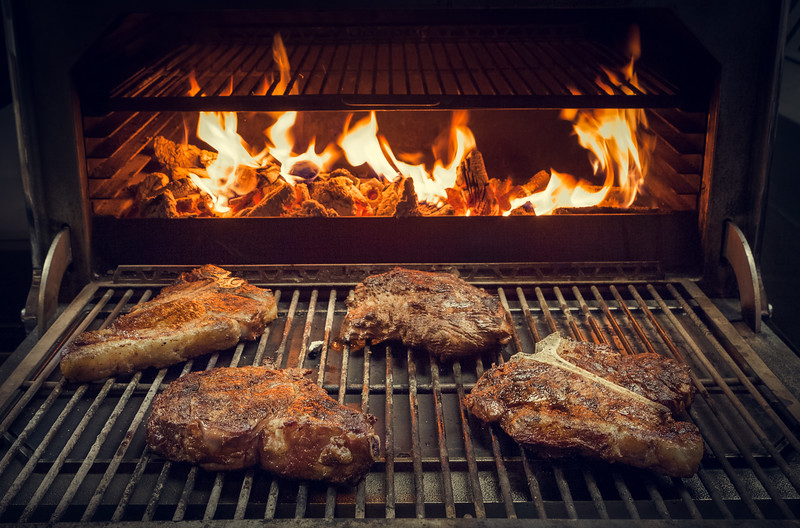
Our Top 10 Tips on How to Cook the Perfect Steak
If you don’t happen to have a charcoal grill, a Josper or a Thermodyne at home, fear not, you can still cook a great steak. In our first book we gave you some tips on how to do that – which we still stand by – so we make no apologies if you’ve read this before.
1. Buy Good Meat
This is the key. But it can be easier said than done – our advice is to find a good butcher and ask lots of questions. Here’s a quick summary of our checklist:
- Make sure your beef is from a traditional British breed.
- Make sure the beef has been grass fed.
- Beef must be slaughtered at more than thirty months old.
- It should be dry-aged for at least twenty-eight days.
2. Buy Big
The aim is to get a good char on the outside while keeping the meat juicy and tender inside; this is very difficult with a thin piece of meat. Ideally each steak should be at least 300g, and 4cm thick. Or buy bigger and share a steak between a couple of people.
3. Take the Meat Out of the Fridge
It needs at least an hour (and if it’s really big then two hours) to properly bring it up to room temperature.
4. Fire Up the BBQ (or, if It’s Raining, Dig Out a Heavy Cast-iron Griddle Pan)
If you’re using a barbecue we recommend lump wood charcoal from sustainable sources, and make sure you use eco-friendly non-impregnated firelighters, to avoid any fuel tainting the flavour of the meat. There are three ingredients in a steak: beef, charcoal and salt. Getting all three right is crucial – there’s no point buying a beautiful piece of beef and using lighter-fuel-impregnated briquettes from the local petrol station.
5. Get the BBQ or the Pan Really, Really Hot
You’re looking for white-hot coals on the barbecue, which will take about an hour from lighting. The grill pan needs 5 minutes over a high heat. It should be painful to hold your hand anywhere near the heat source, which is why our grill chefs have to drink so much water. If you’re inside, open the window – there will be lots of smoke.
6. If Your Steak Is Wet, Dry It
Otherwise it will struggle to form a decent crust and can pick up some unpleasant boiled-meat flavours. And then, at the last minute, season the meat well with Maldon sea salt. You will need to use more than you probably think sensible, but it will help build a delicious salty crust. Pick up a handful of salt in your right hand and your steak in your left. Assuming you steak is the right size (at least 300g and 4cm thick), throw the salt at it and whatever sticks is the right amount. Move the steak around so every surface is coated. If you’re cooking a large sharing steak you’ll need to pat the salt in a little to give you more (yes, more). And if you’ve ended up with skinny minute steaks, use a fair bit less.
7. Don’t Use Any Oil
If the grill is hot enough the meat won’t stick. As well as being unnecessary, oil tends to add a hint of flavour that doesn’t sit well with good beef. If you’re really worried, you can cut a small piece of fat off your steak (or ask your butcher for a piece) and rub it over the grill with a pair of tongs.
8. Stick the Steak on
Leave it for a couple of moments to start building up a crust, then flip. Carry on turning every couple of minutes until it’s the way you like it, and don’t forget to sear the edges. If the head is as fierce as our charcoal grill at Hawksmoor you may need to move it more regularly to avoid burning – our grill chefs say every 5 seconds. Don’t overcrowd the grill or pan – make sure there’s plenty of space between the steaks. If there is a thick layer of fat on your steak, hold it up vertically to brown the fat.
9. Check if Your Steak Is Cooked
You can use touch, which our grill chefs do, or you can use a probe, which our grill chefs also do to make sure every steak is perfect. Cooking temperatures are subjective and perceptions even vary from country to country. These are a touch more cooked than they might be in France or Spain. The internal temperature should be at the bottom end of each range at the end of cooking and towards the top end once rested. (Medium rare 55°c-60°c, Medium 60°c to 65°c, Medium Well 65°c-70°c)
10. Rest Your Meat
When you’re happy with how the steak is cooked, put the steak on a warm plate and leave it to leave to rest for at least five minutes (a really thick steak will be better after ten minutes). In the restaurant we rest meat at 56°c (in a Thermodyne – a special low-temperature over) to ensure it doesn’t get cold, which means we can rest it for longer. Serve on hot plates.
Now you’re ready to tuck in! But, why not start your meal with our popular Pork Belly Ribs, cook up a few delicious sides (we’d recommend Creamed Spinach and Macaroni Cheese) and finally, round off your meal with the iconic Sticky Toffee Pudding.